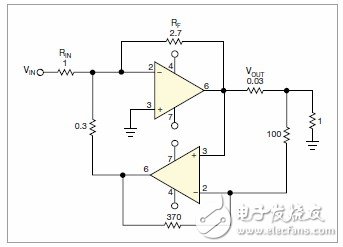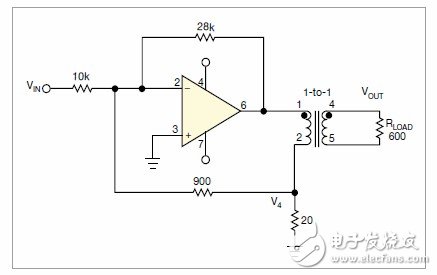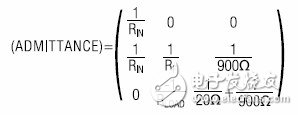Use a series feedback circuit to set the output impedance savings to produce 3dB of output power loss
Series terminations are often used on op amps to match the impedance of the load. But this practical method produces 3dB of output power loss on the termination resistor (Figure 1). The newer op amps operate at 3V and 5V, limiting the output swing, which means that the series matching resistor method should be avoided. Another option is to use a series feedback circuit to set the output impedance. More than 40 years ago, John Wittman, a senior research engineer at GTE Lenkurt Electronics, introduced the technology.

In Figure 1, using a series termination resistor equal to the load wastes 3dB of power, halving the output swing.
With this technique, the output impedance can be increased by 6dB of mutual feedback, resulting in a return loss better than 30dB. What needs to be added is a series current sense resistor, another op amp, and a current limiting resistor (Figure 2). This example shows a high side sensor and an unbalanced load. The forward amplifier is designed to double the gain required for no-load. In this example, the open circuit gain is 2.7 and the input impedance is 1Ω. The input current is 1A and the input signal is 1V.

In Figure 2, this method uses a high-side current-sense resistor and a second amplifier to set the output impedance to match the load so that almost all of the output swing can be achieved.
To match the amplifier's 1Ω load, the series feedback circuit must divert half of the input current from the op amp's negative input. The original 1A input current flows through RF?, reducing to 0.5A, which means that the output voltage is half of the open circuit voltage. The output impedance is now 1Ω and the series feedback is 6dB, so the output impedance can match the load and still get the almost full voltage swing of the amplifier, which will no longer waste half of the output power at the series termination. The current sense resistor value used in this example is 3% of the output load, so the power consumption will be 3%. By careful design, the power consumption can be reduced to less than 1%.
In the telecommunication line, in order to obtain the longitudinal balance, the impedance of the two wires to the ground should be equal. Longitudinal balance prevents crosstalk and 60Hz induced noise. This is also important at the higher frequencies of DSL (Digital Subscriber Line) services. Telecommunications companies typically use transformers to provide a longitudinal balance of 80dB to 120dB. The transformer also isolates the instantaneous flow caused by lightning. The application of this technology can be coupled by transformer coupling with low side current (Figure 3). The design process remains the same, but as long as two resistors provide 6dB of feedback.
The formal equation can be used to formalize the circuit analysis. For the circuit in Figure 2, since the negative input of the op amp is virtual ground, the relationship between input voltage and current can be obtained: IIN = (VIN - V -) / 1 Ω = VIN / 1 Ω. Since the negative input of the op amp is high impedance, the current at this end must be applied to 0A, which yields another equation.
Summarize the current on V-, but the junction current should refer to the sense resistor, including 0.3Ω resistor and 0.03Ω sense resistor: 0=VIN/1Ω+VOUT/2.7Ω+0.37VOUT/ RLOAD. The circuit function can be vectored. And matrix form representation: (I) = (ADMITTANCE) & TImes; (V). It is also possible to expand the appropriate current state:

Then, expand into a vector representation of the voltage:

Substituting these values ​​into (I)=(ADMITTANCE)&TImes;(V), solves (V):

For the circuit in Figure 2, the forced function is I1; the input current is 1A. The voltage vector is obtained by negating the admittance matrix and then multiplying by the current vector. This hard work can be done with HP's HP-48 calculator. The result is: VIN is 1V, and VOUT is calculated to be -1.35V, which is half of the no-load gain of 2.7. This analysis is then repeated for a 1000Ω load resistor:

The matrix (Y) is negated, multiplied by the I matrix, and I1 is 1A, resulting in an open-circuit load voltage vector, VIN equals 1V, and VOUT is -2.7V, confirming that the design is correct.
Be careful when writing your own equations; two subordinate equations can easily lead to incorrect answers. The HP-48 calculator uses the "least squares" solution, but it does not check the determinant's zero condition, warning you that there are non-independent equations. You can add two real matrices with HP-48 to get a complex matrix. This method is convenient when your circuit model contains reactive components. If you prefer to use a computer instead of a pen and paper, you can also use Spice to analyze this circuit.

Figure 3, you can also use the low-side output current detection method to match the output impedance. At this point, there is a transformer-coupled output.
Three equations can be used to analyze the circuit of Figure 3. The input current can be expressed as a function of the input resistance: IIN=(VIN-V-)/RIN=VIN/ RIN. As described in the example above, the current at the negative input of the amplifier is summed to 0:0=VIN/RIN+VOUT/ 28kΩ + (V4-V-) / 900Ω, then add the current of the V4 node: 0 = (V4-V-) / 900Ω + (V4-VOUT) / RLOAD + V4 / 20Ω. Express the current as a vector:

The admittance matrix becomes:

This equation determines the admittance matrix (Y).
At this point, the input current should be 100μA and the load resistance should be 600Ω. The HP-48 calculator is used to invert the admittance matrix and multiply by the current matrix. The obtained voltage matrix can be calculated as an input voltage of 1 V, an output voltage of -1.4 V, and a V4 of -0.05 V. Then, the load is set to 10000 Ω. Assume that the magnetizing inductance of the transformer is infinite. Then repeat the process and get an output voltage of 2.8V.
By modifying the turns ratio of the transformer, the maximum available signal power of the op amp can be matched to the load. The calculated output impedance of the best op amp signal is equal to the peak output voltage swing divided by the maximum peak capability of the op amp.
Front Service Led Display,Outdoor Advertising Screen,Led Screen Billboard,Outdoor Led Advertising
ShenZhen Megagem Tech Co.,Ltd , https://www.megleddisplay.com